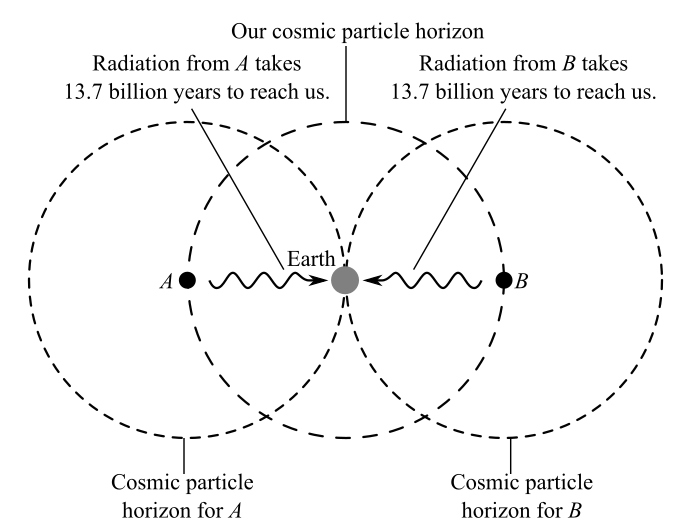
Concept explainers
How the Isotropy problem, as depicted in the below figure, was solved using the inflation model.

Answer to Problem 1CC
Solution:
Isotropy exists in the sky because it is believed that during Inflation epoch, which lasted about
Explanation of Solution
Introduction:
Astronomers and Physicists found that the temperature of microwave background in the sky is isotropic. That means if two points are taken, one in east and one in west, then the two points will have the same temperature. This is a problem in the sense that for temperature equality, the two bodies must be in contact with each other or must interact with each other through photons. Since the universe keeps on growing at a rate much greater than the
Explanation:
It took until the 1980’s to solve the problem of Isotropy in the sky. It was suggested that the universe expanded extremely quickly as about
During this period, the materials that were once together moved far apart rapidly and expanded all across the universe. So the regions that are observed to have same the temperature today were in contact with each in the past and hence they have temperature uniformity though the universe keeps on expanding.
This model is known as Inflationary Model and the behavior of universe in the Inflation epoch successively explains Isotropy problem.
Conclusion:
Want to see more full solutions like this?
Chapter 26 Solutions
Universe
- Would acceleration of the universe occur if it were composed entirely of matter (that is, if there were no dark energy)?arrow_forwardWhat is the fate of a closed universe? In what case would that not be true?arrow_forwardWhy couldnt atomic nuclei exist when the Universe was less than about 2 minutes old?arrow_forward
- What is the difference between hot dark matter and cold dark matter? How does this difference affect cosmology?arrow_forwardDescribe two properties of the universe that are not explained by the standard Big Bang model (without inflation). How does inflation explain these two properties?arrow_forward
 Stars and Galaxies (MindTap Course List)PhysicsISBN:9781337399944Author:Michael A. SeedsPublisher:Cengage Learning
Stars and Galaxies (MindTap Course List)PhysicsISBN:9781337399944Author:Michael A. SeedsPublisher:Cengage Learning Foundations of Astronomy (MindTap Course List)PhysicsISBN:9781337399920Author:Michael A. Seeds, Dana BackmanPublisher:Cengage Learning
Foundations of Astronomy (MindTap Course List)PhysicsISBN:9781337399920Author:Michael A. Seeds, Dana BackmanPublisher:Cengage Learning AstronomyPhysicsISBN:9781938168284Author:Andrew Fraknoi; David Morrison; Sidney C. WolffPublisher:OpenStax
AstronomyPhysicsISBN:9781938168284Author:Andrew Fraknoi; David Morrison; Sidney C. WolffPublisher:OpenStax Principles of Physics: A Calculus-Based TextPhysicsISBN:9781133104261Author:Raymond A. Serway, John W. JewettPublisher:Cengage Learning
Principles of Physics: A Calculus-Based TextPhysicsISBN:9781133104261Author:Raymond A. Serway, John W. JewettPublisher:Cengage Learning Modern PhysicsPhysicsISBN:9781111794378Author:Raymond A. Serway, Clement J. Moses, Curt A. MoyerPublisher:Cengage Learning
Modern PhysicsPhysicsISBN:9781111794378Author:Raymond A. Serway, Clement J. Moses, Curt A. MoyerPublisher:Cengage Learning Physics for Scientists and Engineers with Modern ...PhysicsISBN:9781337553292Author:Raymond A. Serway, John W. JewettPublisher:Cengage Learning
Physics for Scientists and Engineers with Modern ...PhysicsISBN:9781337553292Author:Raymond A. Serway, John W. JewettPublisher:Cengage Learning





